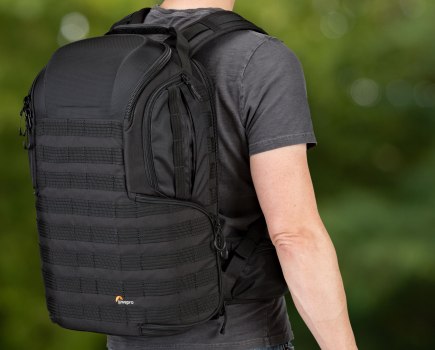Olympus Pen E-PM2 at a glance:
- 16.1-million-pixel, four thirds-sized, Live MOS sensor
- ISO 200-25,600
- Wi-Fi compatible via Eye-Fi or Toshiba Flash
- Air cards
- 324-zone multi-pattern metering
- Street price around £500 with 14-42mm kit lens
Olympus Pen E-PM2 review -Introduction
It may seem an obvious statement, but the major selling point of micro four thirds compact system cameras is their size. By using a smaller sensor than APS-C format, not only can the cameras be made smaller, but so can the lenses, making the overall package much more pocket-sized. Leading the way was the Olympus Pen E-PM1 (also known as the Pen Mini). Not much larger than a compact camera, but with a good range of features, the small and slim E-PM1 is a good travel companion, but is a little lacking in terms of advanced control.
Released last month, the new Olympus Pen E-PM2 (Pen Mini 2) retains the same-sized body as its predecessor, but has a number of new features that make it more than just a cosmetic makeover. Most notably the camera uses the same sensor as in the Olympus OM-D E-M5, which we found produced excellent images. With the Olympus Pen E-PM2 being one of the smallest compact system cameras around, it could prove an interesting option, but does it offer enough control to satisfy the needs of entry-level and advanced photographers?
Features
Perhaps the most significant feature of the Olympus Pen E-PM2 is the four thirds-sized, 16.1-million-pixel, Live MOS sensor. This is a significant upgrade on the 12.1-million-pixel, Live MOS sensor found in the first generation of Pen cameras. The sensitivity range of the E-PM2 has also been increased by 1EV, from ISO 200-12,800 in its predecessor, to ISO 200-25,600. However, the processing engine remains the same TruePic VI system used in the previous generation of Olympus micro four thirds models and the more recent OM-D E-M5. No doubt the system has undergone some tweaks to help tackle the data from the new 16.1-million-pixel sensor.
Don’t be fooled by the size and looks of the E-PM2. Like its predecessors in the Pen range, it has a full range of features for advanced photographers. The camera shoots both JPEG and raw images, with a full range of manual-exposure modes. Exposure compensation and bracketing are available, as are HDR and ISO bracketing.
Another new feature inherited from the OM-D E-M5 is the new live bulb shooting mode. This allows the photographer to use bulb mode with the rear LCD screen updating the live view image every few seconds to show the current exposure. This takes much of the guesswork out of long exposures. Although it is quite a creative, specialist mode, it is fun to experiment with, and it is a credit to Olympus that it has been included in what is its entry-level CSC.
With Wi-Fi connectivity as one of the must-have features this year, it is no surprise to see it included on the E-PM2. Sadly, however, it isn’t built into the camera, although in-camera compatibility is possible with both Eye-Fi and Toshiba Flash Air cards. These will allow images to be transferred from the camera to a laptop computer, smartphone or tablet via the appropriate software or app on the external device.
There are other notable new features and changes to the new camera, but more about these later in the test.
Build and handling

The body of the E-PM2 has a solid metal construction, which is impressive for an entry-level camera costing around £500 including a 14-42mm f/3.5-5.6 kit lens. The size and shape of the camera’s body is largely unchanged since the E-PM1, except for the introduction of a much-needed grip on the front, which enables the right hand to hold the camera more comfortably when shooting.
As expected from an entry-level camera, the button/control arrangement is fairly limited. This is often a problem with the smaller compact system cameras. Thankfully, this new model sees an improvement over the last, with the addition of a new function (Fn) button on the top-plate. This button can be assigned by the user to a particular shooting or exposure function, and I found it relatively straightforward to change any of the most regularly used exposure settings. When using the on-screen menu, options to switch the image style or shooting mode are only a few button presses away.
The 3in screen on the E-PM2 is now a touchscreen, although it is not essential for use and can be switched on or off. I found that the screen worked well for touch focusing on particular areas, but I still instinctively used the buttons to change menu settings. I found this to be a much more comfortable way of working. However, I’d guess that the touchscreen is included to make the camera more appealing to users of compact cameras and mobile phones. Those more used to a DSLR will probably find they hardly use the touchscreen.
Although Olympus introduced a five-axis, sensor-shift, image-stabilisation system in its OM-D E-M5, the E-PM2 only features the standard Olympus three-axis stabilisation. This should, however, be sufficient for most photographers. That said, there has been one new development – in addition to the built-in stabilisation, users will now be able to make use of the optical stabilisation found in Panasonic micro four thirds lenses. This will be of benefit to some photographers who may find that lens stabilisation is better than in-camera stabilisation when using telephoto lenses. Switching between stabilisation systems is done via the camera’s menu.
The camera’s start-up time has also been improved to around 0.5secs from switching on to picture-readiness. This improvement complements the new Olympus 15mm f/8 Body Cap lens (see Testbench, Amateur Photographer, 3 November 2012). At just 9mm thick, the lens is around the same size as a body cap, hence its name. It has a fixed f/8 aperture and focus settings of 30cm or infinity. The idea is that this lens can be kept on the camera at all times when in storage, and with little in terms of adjustments it is always ready to point and shoot, just like a camera phone. The lens was a lot of fun to use in social surroundings, and while it won’t produce any award-winning landscapes or wildlife images, it is possible to get some great documentary and candid shots. Even better, I could fit the camera and Body Cap lens in the jacket pocket of a suit, making it a really good portable solution.
Metering
Overall, the 324-zone multi-pattern metering system of the E-PM2 works well. Faced with high-contrast landscape scenes, I found the system was able to strike a nice balance between burning out some highlight detail and ensuring there was enough detail in shadow areas. One of the advantages of Olympus CSCs is their highlight and shadow spot metering modes. These can be used to retain detail in shadows or highlights and are extremely useful in high-contrast situations, when it is necessary to retain detail in one particular area above another.
Dynamic range
There is a noticeable improvement in the dynamic range of the E-PM2 compared to the last generation of Olympus micro four thirds cameras. The basic 12.1-million-pixel, four thirds-sized sensor first appeared as far back as 2009 in the Olympus E-30, and although changes have been made in the years since, the new 16.1-million-pixel unit has still more current technology to help ensure improved dynamic range and noise reduction. As a result, there is more detail in highlight and shadow areas, and high-contrast images are improved.
Noise, resolution and sensitivity

While image resolution is good for a camera with 16.1 million pixels, it is noise that has previously been a problem with four thirds cameras. Overall, the new sensor is a big improvement. Colour noise in JPEG images is kept to an absolute minimum, even at high sensitivities, and is quite easily removed from raw images.
Luminance noise is also more subtle, although, as expected, luminance noise reduction does cause a loss of detail at high sensitivities. For most photographers, noise shouldn’t be an issue at all.
This is not to say that there isn’t noise visible in the usual ISO 200-800 working range of most photographers. Pixel peeping at images with a 100% magnification does occasionally reveal slightly sharpened edges that look like a small amount of luminance noise removal has been applied, along with edge sharpening.
Given that the intention of the E-PM2 is really to make sure that a photographer has a small discreet camera to get the shot they need, rather than worrying about whether they can make billboard-sized enlargements, I wouldn’t be overly concerned about the hint of luminance noise or its removal.
The sensor is very impressive, and those who were happy with the images from the E-PM1’s 12.1-million-pixel sensor will be very pleased with the images from the 16.1-million-pixel E-PM2 unit.
These images show 72ppi (100% on a computer screen) sections of images of a resolution chart, captured using the Sigma 105mm f/2.8 macro lens. We show the section of the resolution chart where the camera starts to fail to reproduce the lines separately. The higher the number visible in these images, the better the camera’s detail resolution at the specified sensitivity setting.
Autofocus
For this new model the AF system has been overhauled. It is now faster, and more comparable in speed to the latest Panasonic micro four thirds cameras. The E-PM2 snaps into focus very quickly, and is noticeably faster than its predecessor.
Speed isn’t the only improvement here. While there are 35 AF points in automatic modes, there are now up to 800 selectable areas of magnification in manual-focus mode. Pressing a touchscreen button brings up a magnified view of one of these areas to allow for very precise focusing. The system works well, and is simple to implement and manually focus.
As is now standard, face detection and focus tracking are also available.
Viewfinder, LCD and video

As the E-PM2 has the same accessory socket as the previous generation of Pen cameras, the optional electronic viewfinder can be used for those who require a viewfinder. Otherwise, by default, it is the rear 3in widescreen, 460,000-dot screen that is used to view images. This is bright and shows a reasonable level of detail, but it is noticeable that it doesn’t have as high a resolution as the 921,000-dot screens found on most DSLRs and some other CSCs. However, once again, for the intended market, it shouldn’t present a problem.
Video capture is fairly impressive, with full HD 1920×1080-pixel capture at 30fps, with MPEG4/H.264 compression at a 20Mbps data rate. Audio is captured in stereo using the internal microphone, which has a recording level and wind noise reduction functions.
White balance and colour

Image: Even in the default setting, colours are bright and punchy
As with previous Olympus cameras, the E-PM2 features a wealth of different colour styles and art filters.
The default colour settings are very good, creating bright, bold and reasonably vivid images,
although I found the vivid mode to be a little too punchy, with some colours reaching saturation point. It is possible to tweak all of the default image styles according to personal taste, including adding colour filter effects to the monochrome mode.
The art filters are very quick to access via the image style menu, rather than being tucked away in a different menu as they were on some previous Pen models.
Although these effects may only be of a passing interest to more serious photographers, there are some useful creative effects to be found in-camera, such as the grainy black & white setting, and the rather over-the-top dramatic tone mode.
 Image: The in-camera monochrome shooting mode has a nice level of contrast. It can be adjusted using either the strength setting, or by applying a digital colour filter effect
Image: The in-camera monochrome shooting mode has a nice level of contrast. It can be adjusted using either the strength setting, or by applying a digital colour filter effect
Our verdict
Don’t be put off or fooled by the rather simplistic menu layout and the art filters, which may not be to everyone’s taste. The Olympus Pen E-PM2 is a very capable little camera, and would be ideal for someone looking for a CSC for occasional use alongside a more advanced DSLR. It will be interesting to see how the new Pen E-PL5 (Pen Lite) fares in our test in a few weeks’ time, and to see exactly what features it adds to the Olympus Pen range.
Those wanting an experience and image quality more on a par with using a DSLR may be better served by the Sony NEX or Samsung NX ranges, but as far as a small, light CSC is capable of producing good images, you can’t go far wrong with the E-PM2.







